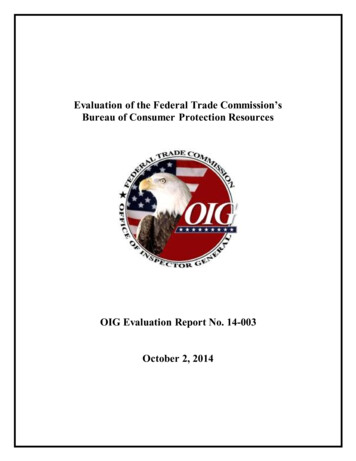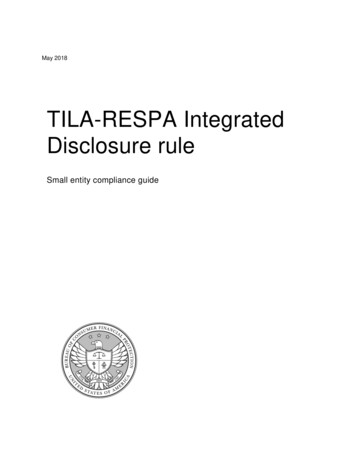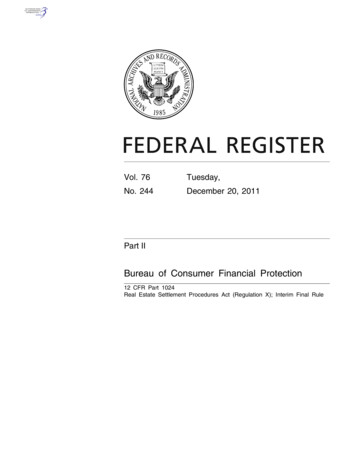
Transcription
Vol. 76Tuesday,No. 244December 20, 2011Part IIBureau of Consumer Financial Protectionmstockstill on DSK4VPTVN1PROD with RULES212 CFR Part 1024Real Estate Settlement Procedures Act (Regulation X); Interim Final RuleVerDate Mar 15 201017:18 Dec 19, 2011Jkt 226001PO 00000Frm 00001Fmt 4717Sfmt 4717E:\FR\FM\20DER2.SGM20DER2
78978Federal Register / Vol. 76, No. 244 / Tuesday, December 20, 2011 / Rules and RegulationsBUREAU OF CONSUMER FINANCIALPROTECTION12 CFR Part 1024[Docket No. CFPB–2011–0030]RIN 3170–AA06Real Estate Settlement Procedures Act(Regulation X)Bureau of Consumer FinancialProtection.ACTION: Interim final rule with requestfor public comment.AGENCY:Title X of the Dodd-FrankWall Street Reform and ConsumerProtection Act (Dodd-Frank Act)transferred rulemaking authority for anumber of consumer financialprotection laws from seven Federalagencies to the Bureau of ConsumerFinancial Protection (Bureau) as of July21, 2011. The Bureau is in the processof republishing the regulationsimplementing those laws with technicaland conforming changes to reflect thetransfer of authority and certain otherchanges made by the Dodd-Frank Act.In light of the transfer of the Departmentof Housing and Urban Development’s(HUD’s) rulemaking authority for theReal Estate Settlement Procedures Act(RESPA) to the Bureau, the Bureau ispublishing for public comment aninterim final rule establishing a newRegulation X (Real Estate SettlementProcedures Act). This interim final ruledoes not impose any new substantiveobligations on persons subject to theexisting Regulation X, previouslypublished by HUD.DATES: This interim final rule iseffective December 30, 2011. Commentsmust be received on or before February21, 2012.ADDRESSES: You may submit comments,identified by Docket No. CFPB–2011–0030 or RIN 3170–AA06, by any of thefollowing methods: Electronic: http://www.regulations.gov. Follow theinstructions for submitting comments. Mail: Monica Jackson, Office of theExecutive Secretary, Bureau ofConsumer Financial Protection, 1500Pennsylvania Ave. NW., (Attn: 1801 LStreet), Washington, DC 20220. Hand Delivery/Courier in Lieu ofMail: Monica Jackson, Office of theExecutive Secretary, Bureau ofConsumer Financial Protection, 1700 GStreet NW., Washington, DC 20006.All submissions must include theagency name and docket number orRegulatory Information Number (RIN)for this rulemaking. In general, allcomments received will be postedmstockstill on DSK4VPTVN1PROD with RULES2SUMMARY:VerDate Mar 15 201017:18 Dec 19, 2011Jkt 226001without change to http://www.regulations.gov. In addition,comments will be available for publicinspection and copying at 1700 G StreetNW., Washington, DC 20006, on officialbusiness days between the hours of10 a.m. and 5 p.m. Eastern Time. Youcan make an appointment to inspect thedocuments by telephoning (202) 435–7275.All comments, including attachmentsand other supporting materials, willbecome part of the public record andsubject to public disclosure. Sensitivepersonal information, such as accountnumbers or social security numbers,should not be included. Comments willnot be edited to remove any identifyingor contact information.FOR FURTHER INFORMATION CONTACT:Joseph Devlin or Jane Gao, Office ofRegulations, at (202) 435–7700.SUPPLEMENTARY INFORMATION:I. BackgroundCongress enacted the Real EstateSettlement Procedures Act of 1974(RESPA) based on findings thatsignificant reforms in the real estatesettlement process were needed toensure that consumers are providedwith greater and more timelyinformation on the nature and costs ofthe residential real estate settlementprocess and are protected fromunnecessarily high settlement chargescaused by certain abusive practices thatCongress found to have developed. Inaddition to providing consumers withappropriate disclosures, the purposes ofRESPA include effecting certain changesin the settlement process for residentialreal estate that will result in (1) theelimination of kickbacks or referral feesthat Congress found to increaseunnecessarily the costs of certainsettlement services; and (2) a reductionin the amounts home buyers arerequired to place in escrow accountsestablished to insure the payment of realestate taxes and insurance.1 RESPA alsoprohibits unearned fees in connectionwith federally related mortgage loans. In1990, Congress amended RESPA byadding a new section 6 covering personsresponsible for servicing mortgage loansand amending statutory provisionsrelated to mortgage servicers’administration of borrowers’ escrowaccounts.2Historically, RESPA has beenimplemented in Regulation X of theDepartment of Housing and UrbanDevelopment (HUD), 24 CFR part 3500.The Dodd-Frank Wall Street Reform and1 12U.S.C. 2601.Law 101–625, 104 Stat. 4079 (1990),Sections 941–42.2 PublicPO 00000Frm 00002Fmt 4701Sfmt 4700Consumer Protection Act (Dodd-FrankAct) 3 amended a number of consumerfinancial protection laws, includingRESPA. In addition to varioussubstantive amendments, the DoddFrank Act transferred rulemakingauthority for RESPA to the Bureau,effective July 21, 2011. See sections1061 and 1098 of the Dodd-Frank Act.Pursuant to the Dodd-Frank Act andRESPA, as amended, the Bureau ispublishing for public comment aninterim final rule establishing a newRegulation X (Real Estate SettlementProcedures Act), 12 CFR part 1024,implementing RESPA.II. Summary of the Interim Final RuleA. GeneralThe interim final rule substantiallyduplicates HUD’s Regulation X as theBureau’s new Regulation X, 12 CFR part1024, making only certain nonsubstantive, technical, formatting, andstylistic changes. To minimize anypotential confusion, other thanrepublishing HUD’s rule (24 CFR part3500) with the Bureau’s part number,the Bureau is preserving where possiblethe section numbering HUD used in 24CFR part 3500. For example, while thisinterim final rule generally incorporatesHUD’s existing regulatory text andappendices (including standardized andmodel forms), the rule has been editedas necessary to reflect nomenclature andother technical amendments required bythe Dodd-Frank Act. Notably, thisinterim final rule does not impose anynew substantive obligations onregulated entities. In futurerulemakings, the Bureau expects toamend Regulation X to implementcertain other changes to RESPA made bythe Dodd-Frank Act, such as preparingand distributing booklets ‘‘jointlyaddressing compliance with therequirements of the Truth in LendingAct and [RESPA], in order to helppersons borrowing money to finance thepurchase of residential real estate betterto understand the nature and costs ofreal estate settlement services,’’ 4integrating certain disclosurerequirements of the Truth in LendingAct, 15 U.S.C. 1601 et seq., with certaindisclosure requirements of RESPA,5adopting regulations pertaining topractices of mortgage servicers, andissuing regulations to carry out theconsumer purposes of RESPA.3 PublicLaw 111–203, 124 Stat. 1376 (2010).Law 111–203, Section 1098(3).Accordingly, pending further Bureau action, theBureau is adopting HUD’s existing booklet onsettlement costs.5 Id. at Section 1032(f).4 PublicE:\FR\FM\20DER2.SGM20DER2
Federal Register / Vol. 76, No. 244 / Tuesday, December 20, 2011 / Rules and Regulationsmstockstill on DSK4VPTVN1PROD with RULES2B. Specific ChangesReferences to HUD and itsadministrative structure, includingprovisions for imposing penalties forescrow violations, have been replacedwith references to the Bureau.Conforming edits have been made tointernal cross-references and addressesfor filing applications and notices.Conforming edits have also been madeto reflect the scope of the Bureau’sauthority pursuant to RESPA, asamended by the Dodd-Frank Act.Historical references that are no longerapplicable, and references to effectivedates that have passed, have beenremoved as appropriate. In addition, theBureau is correcting a citation error inHUD’s existing § 3500.17(l)(4). Asadopted by HUD, § 3500.17(l)(4)contains a cross-reference to§ 3500.21(f). The correct citation shouldbe to § 3500.21(e). The Bureau isrepublishing § 3500.17(l)(4) as§ 1024.17(l)(4) with the citationcorrected to read § 1024.21(e).References to any ‘‘HUD PublicGuidance Document’’ throughout HUD’sRegulation X have been replaced withreferences to a ‘‘Public GuidanceDocument’’ throughout the Bureau’sRegulation X. HUD’s existing RegulationX CFR text contains several provisionsthat HUD adopted in 1996 but nevermade effective.6 The Bureau is notrepublishing those provisions with theBureau’s Regulation X. Furthermore, theBureau is clarifying permissible changesthat covered persons may make to thespecial information booklet without theBureau’s written approval. As adoptedby HUD, §§ 3500.6(d)(2) and (3) set forththe permissible changes that coveredpersons may make in the specialinformation booklet without writtenapproval from the Secretary of HUD. Toreflect the transfer of authority fromHUD to the Bureau, the Bureau isrecodifying § 3500.6(d)(1) as§§ 1024.6(d)(1)(i) and (ii) to clarifypermissible changes covered personsmay make to the special informationbooklet without the Bureau’s writtenapproval.As discussed above, the Dodd-FrankAct directed the Bureau to integratecertain disclosures required by TILAwith certain disclosures required byRESPA. The Bureau expects the contentand format of HUD’s existing HUD–1/1A and GFE forms to be significantlyrevised or replaced by such rulemaking.The HUD–1/1A and GFE formscurrently list HUD’s Office ofManagement and Budget (OMB) control6 See Notice of Final Rule and Delay ofEffectiveness, 61 Fed. Reg. 51782 (October 4, 1996).VerDate Mar 15 201017:18 Dec 19, 2011Jkt 226001number, 2502–0265, in order to satisfycertain information collectionrequirements of the PaperworkReduction Act. The Bureau believes thatrequiring covered persons to modifyexisting forms solely to replace HUD’sOMB control number with the Bureau’sOMB control number would imposesubstantial burden on covered personswith limited or no net benefit toconsumers. Accordingly, coveredpersons may continue to list HUD’sOMB control number on the HUD–1/1Aand GFE forms until a final rule to thecontrary takes effect. Covered personsalso have the option of replacing HUD’sOMB control number with the Bureau’sOMB control number on the HUD–1/1Aand GFE forms until a final rule to thecontrary takes effect.Accordingly, the Bureau is addinglanguage in Appendix C to part 1024—Instructions for Completing the GoodFaith Estimate (GFE) Form to clarify thatcovered persons may replace HUD’sOMB control number with the Bureau’sOMB control number on the form attheir option. HUD’s existing § 3500.9lists the permissible changes allowedwhen the HUD–1/1A settlement changesare reproduced. The Bureau isrecodifying § 3500.9 as § 1024.9 andadding language in § 1024.9(c) to clarifythat covered persons may replace HUD’sOMB control number with the Bureau’sOMB Control number on the HUD–1/1Aforms without written approval from theBureau. Furthermore, the Bureau isrevising language in § 1024.9(a)(5) toclarify that covered persons are notrequired to display the expiration datethat is associated with the OMB controlnumber displayed on the HUD–1/1Aforms.The Bureau has certain informationgathering and investigative authorityconcerning Federal consumer financiallaws, including RESPA,7 underSubtitles B and E of the Dodd-FrankAct. RESPA also confers additionalinformation gathering and investigativeauthority on the Bureau. Accordingly,the Bureau is removing paragraphs (i)and (ii) in HUD’s existing § 3500.17(l)(3)because the repetition of the RESPAconferred information gathering andinvestigative authority therein isunnecessary.The Bureau has the authority toenforce RESPA and Regulation Xpursuant to Subtitle E of Title X of theDodd-Frank Act.8 RESPA also confersadditional enforcement authority on the7 See Public Law 111–203, Section 1002(12)(M)(defining RESPA as an ‘‘enumerated law.’’) Anenumerated consumer law is a ‘‘Federal consumerfinancial law.’’ Id. at Section 1002(14).8 Id. at Sections 1051–1057.PO 00000Frm 00003Fmt 4701Sfmt 470078979Bureau. The Bureau is removing thecivil money penalties provisions inHUD’s existing § 3500.17(m) and (n)because the repetition of this RESPAconferred authority is unnecessary.Investigations undertaken by the Bureauwill be conducted in accordance with12 CFR part 1080, and administrativeadjudications will be conducted inaccordance with 12 CFR part 1081. Dueto the removal of paragraphs (m) and (n)from § 3500.17, the ‘‘Discretionarypayments’’ paragraph in HUD’s existing§ 3500.17(o) is being recodified as§ 1024.17(m) in this interim final rule.Finally, the Bureau is removingparagraphs (b) and (c) from HUD’sexisting § 3500.19 because they arerepetitive in light of other statutory andregulatory provisions. See §§ 3500.14–16 (being recodified as §§ 1024.14–16).Accordingly, corresponding crossreferences to §§ 3500.19(b) and (c) inHUD’s existing Regulation X are alsobeing removed,9 and § 3500.19(d) isbeing recodified as § 1024.19(b).III. Legal AuthorityA. Rulemaking AuthorityThe Bureau is issuing this interimfinal rule pursuant to its authority underRESPA and the Dodd-Frank Act.Effective July 21, 2011, section 1061 ofthe Dodd-Frank Act transferred to theBureau all of the HUD Secretary’sconsumer protection functions relatingto RESPA.10 Accordingly, effective July21, 2011, the authority of HUD to issueregulations pursuant to RESPAtransferred to the Bureau.11RESPA, as amended, authorizes theBureau to issue regulations to carry outthe provisions of RESPA.12 Thisauthority allows the Bureau to prescribesuch rules and regulations, to makesuch interpretations, and to grant suchreasonable exemptions for classes oftransactions, as may be necessary toachieve the purposes of RESPA. In itsexisting regulation, HUD has used this9 See § 3500.14(a) (being recodified as§ 1024.14(a)) and § 3500.16 (being recodified as§ 1024.16).10 Public Law 111–203, 1061(b)(7)(A). Effectiveon the designated transfer date, July 21, 2011, theBureau was also granted ‘‘all powers and duties’’that were vested in the HUD Secretary relating toRESPA on the date before the designated transferdate. Id. at Section 1061(b)(7)(B). Until this andother interim final rules take effect, existingregulations for which rulemaking authoritytransferred to the Bureau continue to governpersons covered by this rule. See 76 FR 43569 (July21, 2011).11 Section 1066 of the Dodd-Frank Act grants theSecretary of the Treasury interim authority toperform certain functions of the Bureau. Pursuantto that authority, Treasury is publishing this interimfinal rule on behalf of the Bureau.12 Public Law 111–203, Section 1098(11); 12U.S.C. 2603–2605, 2607, 2609, 2617.E:\FR\FM\20DER2.SGM20DER2
78980Federal Register / Vol. 76, No. 244 / Tuesday, December 20, 2011 / Rules and Regulationsmstockstill on DSK4VPTVN1PROD with RULES2RESPA authority to establish extensiverules concerning appropriate and timelydisclosures about the nature and costs ofthe residential real estate settlementprocess, the elimination of kickbacks orreferral fees with respect to certainsettlement services, and mortgageservicers’ administration of borrowers’escrow accounts, as well as theirhandling of servicing transfers andwritten consumer inquiries.13B. Authority To Issue an Interim FinalRule Without Prior Notice and CommentThe Administrative Procedure Act(APA) 14 generally requires publicnotice and an opportunity to commentbefore promulgation of substantiveregulations.15 The APA providesexceptions to notice-and-commentprocedures, however, where an agencyfor good cause finds that suchprocedures are impracticable,unnecessary, or contrary to the publicinterest or when a rulemaking relates toagency organization, procedure, andpractice.16 The Bureau finds that thereis good cause to conclude that providingnotice and opportunity for commentwould be unnecessary and contrary tothe public interest under thesecircumstances. In addition, substantiallyall of the changes made by this interimfinal rule, which were necessitated bythe Dodd-Frank Act’s transfer of RESPAauthority from HUD to the Bureau,relate to agency organization, procedure,and practice and are thus exempt fromthe APA’s notice-and-commentrequirements.The Bureau’s good cause findings arebased on the following considerations.As an initial matter, HUD’s existingregulation was a result of notice-andcomment rulemaking to the extentrequired. Moreover, the interim finalrule published today does not imposeany new, substantive obligations onregulated entities. Rather, the interimfinal rule makes only non-substantive,technical changes to the existing text ofthe regulation, such as renumbering,changing internal cross-references,replacing appropriate nomenclature toreflect the transfer of authority to theBureau, and changing the address forfiling applications and notices. Giventhe technical nature of these changes,and the fact that the interim final ruledoes not impose any additionalsubstantive requirements on coveredentities, an opportunity for prior publiccomment is unnecessary. In addition,recodifying HUD’s regulation to reflect13 SeeHUD’s Regulation X, 24 CFR part 3500.U.S.C. 551 et seq.15 5 U.S.C. 553(b), (c).16 5 U.S.C. 553(b)(3)(A), (B).14 5VerDate Mar 15 201017:18 Dec 19, 2011Jkt 226001the transfer of authority to the Bureauwill help facilitate compliance withRESPA and its implementingregulations, and will help reduceuncertainty regarding the applicableregulatory framework. Using notice-andcomment procedures would delay thisprocess and thus be contrary to thepublic interest.The APA generally requires that rulesbe published not less than 30 daysbefore their effective dates. See 5 U.S.C.553(d). As with the notice and commentrequirement, however, the APA allowsan exception when ‘‘otherwise providedby the agency for good cause found andpublished with the rule.’’ 5 U.S.C.553(d)(3). The Bureau finds that there isgood cause for providing less than 30days notice here. A delayed effectivedate would harm consumers andregulated entities by needlesslyperpetuating discrepancies between theamended statutory text and theimplementing regulation, therebyhindering compliance and prolonginguncertainty regarding the applicableregulatory framework.17In addition, delaying the effectivedate of the interim final rule for 30 dayswould provide no practical benefit toregulated entities in this context and infact could operate to their detriment. Asdiscussed above, the interim final rulepublished today does not impose anynew, substantive obligations onregulated entities. Instead, the rulemakes only non-substantive, technicalchanges to the existing text of theregulation. Thus, regulated entities thatare already in compliance with theexisting rules will not need to modifybusiness practices as a result of thisrule.C. Section 1022(b)(2) of the Dodd-FrankActIn developing the interim final rule,the Bureau has conducted an analysis ofpotential benefits, costs, and impacts.18The Bureau believes that the interimfinal rule will benefit consumers andcovered persons by updating andrecodifying Regulation X to reflect thetransfer of authority to the Bureau andcertain other changes mandated by theDodd-Frank Act. This will helpfacilitate compliance with RESPA andits implementing regulations and helpreduce any uncertainty regarding theapplicable regulatory framework. Theinterim final rule will not impose anynew substantive obligations onconsumers or covered persons and isnot expected to have any impact onconsumers’ access to consumer financialproducts and services.Although not required by the interimfinal rule, covered entities may incursome costs in updating compliancemanuals and related materials to reflectthe new numbering and other technicalchanges reflected in the new RegulationX. The Bureau has worked to reduce anysuch burden by preserving the existingnumbering to the extent possible andbelieves that such costs will likely beminimal. These changes could behandled in the short term by providinga short, standalone summary alertingusers to the changes and in the longterm could be combined with otherupdates at the firm’s convenience. TheBureau intends to continue investigatingthe possible costs to affected entities ofupdating manuals and related materialsto reflect these changes and solicitscomments on this and other issuesdiscussed in this section.The interim final rule will have nounique impact on depositoryinstitutions or credit unions with 10billion or less in assets as described insection 1026(a) of the Dodd-Frank Act.Also, the interim final rule will have nounique impact on rural consumers.In undertaking the process ofrecodifying Regulation X, as well asregulations implementing thirteen otherexisting consumer financial laws,19 the17 This interim final rule is one of 14 companionrulemakings that together restate and recodify theimplementing regulations under 14 existingconsumer financial laws (part III.C, below, lists the14 laws involved). In the interest of propercoordination of this overall regulatory framework,which includes numerous cross-references amongsome of the regulations, the Bureau is establishingthe same effective date of December 30, 2011 forthose rules published on or before that date andmaking those published thereafter (if any) effectiveimmediately.18 Section 1022(b)(2)(A) of the Dodd-Frank Actaddresses the consideration of the potential benefitsand costs of regulation to consumers and coveredpersons, including the potential reduction of accessby consumers to consumer financial products orservices; the impact on depository institutions andcredit unions with 10 billion or less in total assetsas described in Section 1026 of the Dodd-Frank Act;and the impact on consumers in rural areas. Section1022(b)(2)(B) requires that the Bureau ‘‘consult withthe appropriate prudential regulators or otherFederal agencies prior to proposing a rule andduring the comment process regarding consistencywith prudential, market, or systemic objectivesadministered by such agencies.’’ The manner andextent to which these provisions apply to interimfinal rules and to benefits, costs, and impacts thatare compelled by statutory changes rather thandiscretionary Bureau action is unclear.Nevertheless, to inform this rulemaking more fully,the Bureau performed the described analyses andconsultations.19 The fourteen laws implemented by this and itscompanion rulemakings are: The Consumer LeasingAct, the Electronic Fund Transfer Act (except withrespect to Section 920 of that Act), the Equal CreditOpportunity Act, the Fair Credit Reporting Act(except with respect to Sections 615(e) and 628 ofthat act), the Fair Debt Collection Practices Act,Subsections (b) through (f) of Section 43 of theFederal Deposit Insurance Act, Sections 502through 509 of the Gramm-Leach-Bliley Act (exceptPO 00000Frm 00004Fmt 4701Sfmt 4700E:\FR\FM\20DER2.SGM20DER2
Federal Register / Vol. 76, No. 244 / Tuesday, December 20, 2011 / Rules and RegulationsBureau consulted the Federal DepositInsurance Corporation, the Office of theComptroller of the Currency, theNational Credit Union Administration,the Board of Governors of the FederalReserve System, the Federal TradeCommission, and the Department ofHousing and Urban Development,including with respect to consistencywith any prudential, market, or systemicobjectives that may be administered bysuch agencies.20 The Bureau also hasconsulted with the Office ofManagement and Budget for technicalassistance. The Bureau expects to havefurther consultations with theappropriate Federal agencies during thecomment period.IV. Request for CommentAlthough notice and commentrulemaking procedures are not required,the Bureau invites comments on thisnotice. Commenters are specificallyencouraged to identify any technicalissues raised by the rule. The Bureau isalso seeking comment in response to anotice published at 76 FR 75825 (Dec.5, 2011) concerning its efforts to identifypriorities for streamlining regulationsthat it has inherited from other Federalagencies to address provisions that areoutdated, unduly burdensome, orunnecessary.mstockstill on DSK4VPTVN1PROD with RULES2V. Regulatory Flexibility ActThe Regulatory Flexibility Act (RFA),as amended by the Small BusinessRegulatory Enforcement Fairness Act of1996, requires each agency to considerthe potential impact of its regulations onsmall entities, including smallbusinesses, small governmental units,and small not-for-profit organizations.21The RFA generally requires an agency toconduct an initial regulatory flexibilityanalysis (IRFA) and a final regulatoryflexibility analysis (FRFA) of any rulesubject to notice-and-commentrulemaking requirements, unless theagency certifies that the rule will nothave a significant economic impact ona substantial number of small entities.22The Bureau also is subject to certainadditional procedures under the RFAfor Section 505 as it applies to Section 501(b)), theHome Mortgage Disclosure Act, the Real EstateSettlement Procedures Act, the S.A.F.E. MortgageLicensing Act, the Truth in Lending Act, the Truthin Savings Act, Section 626 of the OmnibusAppropriations Act, 2009, and the Interstate LandSales Full Disclosure Act.20 In light of the technical but voluminous natureof this recodification project, the Bureau focusedthe consultation process on a representative sampleof the recodified regulations, while makinginformation on the other regulations available. TheBureau expects to conduct differently its futureconsultations regarding substantive rulemakings.21 5 U.S.C. 601 et seq.22 5 U.S.C. 603, 604.VerDate Mar 15 201017:18 Dec 19, 2011Jkt 226001involving the convening of a panel toconsult with small businessrepresentatives prior to proposing a rulefor which an IRFA is required.23The IRFA and FRFA requirementsdescribed above apply only where anotice of proposed rulemaking isrequired,24 and the panel requirementapplies only when a rulemakingrequires an IRFA.25 As discussed abovein part III, a notice of proposedrulemaking is not required for thisrulemaking.In addition, as discussed above, thisinterim final rule has only a minorimpact on entities subject to RegulationX. The rule imposes no new, substantiveobligations on covered entities.Accordingly, the undersigned certifiesthat this interim final rule will not havea significant economic impact on asubstantial number of small entities.VI. Paperwork Reduction ActThe Bureau may not conduct orsponsor, and a respondent is notrequired to respond to, an informationcollection unless it displays a currentlyvalid Office of Management and Budget(OMB) control number. This rulecontains information collectionrequirements under the PaperworkReduction Act (PRA), which have beenpreviously approved by OMB, the OMBcontrol number for which is 2502–0265,and the ongoing PRA burden for whichis unchanged by this rule. There are nonew information collectionrequirements in this interim final rule.The Bureau’s OMB control number forthis information collection is: 3170–0016.List of Subjects in 12 CFR Part 1024Consumer protection, Condominiums,Housing, Mortgages, Mortgagees,Mortgage servicing, Reporting andrecordkeeping requirements.Authority and IssuanceFor the reasons set forth above, theBureau of Consumer FinancialProtection adds part 1024 to Chapter Xin Title 12 of the Code of FederalRegulations to read as follows: PART 1024—REAL ESTATESETTLEMENT PROCEDURES ACT(REGULATION X)Sec.1024.1 Designation.1024.2 Definitions.1024.3 Questions or suggestions frompublic and copies of public guidancedocuments.23 5U.S.C. 609.U.S.C. 603(a), 604(a); 5 U.S.C. 553(b)(B).25 5 U.S.C. 609(b).24 5PO 00000Frm 00005Fmt 4701Sfmt 4700789811024.4 Reliance upon rule, regulation orinterpretation by the Bureau.1024.5 Coverage of RESPA.1024.6 Special information booklet at timeof loan application.1024.7 Good faith estimate.1024.8 Use of HUD–1 or HUD–1Asettlement statements.1024.9 Reproduction of settlementstatements.1024.10 One-day advance inspection ofHUD–1 or HUD–1A settlementstatement; delivery; recordkeeping.1024.11 Mailing.1024.12 No fee.1024.13 Relation to state laws.1024.14 Prohibition against kickbacks andunearned fees.1024.15 Affiliated business arrangements.1024.16 Title companies.1024.17 Escrow accounts.1024.18 Validity of contracts and liens.1024.19 Enforcement.1024.20 [Reserved]1024.21 Mortgage servicing transfers.1024.22 Severability.1024.23 ESIGN applicability.Appendix A to Part 1024—Instructions forCompleting HUD–1 and HUD–1ASettlement Statements; Sample HUD–1and HUD–1A StatementsAppendix B to Part 1024—Illustrations ofRequirements of RESPAAppendix C to Part 1024—Instructions forCompleting Good Faith Estimate (GFE)FormAppendix D to Part 1024—AffiliatedBusiness Arrangement DisclosureStatement FormatAppendix E to Part 1024—Arithmetic StepsAppendix MS–1 to Part 1024—ServicingDisclosure StatementAppendix MS–2 to Part 1024—Notice ofAssignment, Sale, or Transfer ofServicing RightsAuthority: 12 U.S.C. 2603–2605, 2607,2609, 2617, 5512, 5581.§ 1024.1Designation.This part, known as Regulation X, isissued by the Bureau of ConsumerFinancial Protection to implement theReal Estate Settlement Procedures Act of1974, as amended, 12 U.S.C. 2601 et.seq.§ 1024.2Definitions.(a) Statutory terms. All terms definedin RESPA (12 U.S.C. 2602) are used inaccordance with their statutory meaningunless otherwise defined in paragraph(b) of this section or elsewhere in thispart.(b) Other terms. As used in this part:Application means the submission ofa borrower’s financial information inanticipation of a credit decision relatingto a federally related mortgage loan,which shall include the borrower’sname, the borrower’s monthly income,the borrower’s social security number toobtain a credit report, the propertyaddress, an estimate of the value of theE:\FR\FM\20DER2.SGM20DER2
mstockstill on DSK4VPTVN1PROD with RULES278982Federal Register / Vol. 76, No. 244 / Tuesday, December 20, 2011 / Rules and Regulationsproperty, the mortgage loan amountsought, and any other informationdeem
in the amounts home buyers are required to place in escrow accounts established to insure the payment of real estate taxes and insurance.1 RESPA also prohibits unearned fees in connection with federally related mortgage loans. In 1990, Congress amended RESPA by adding a new section 6 covering persons responsible for servicing mortgage loans
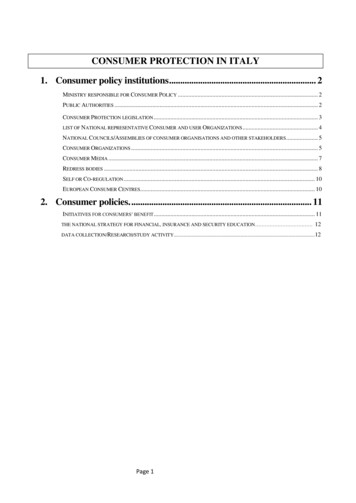
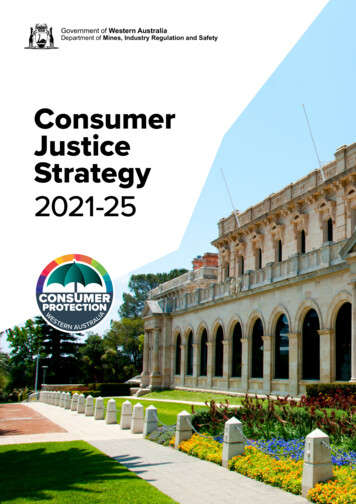

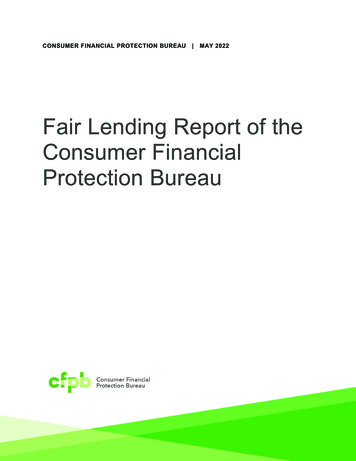
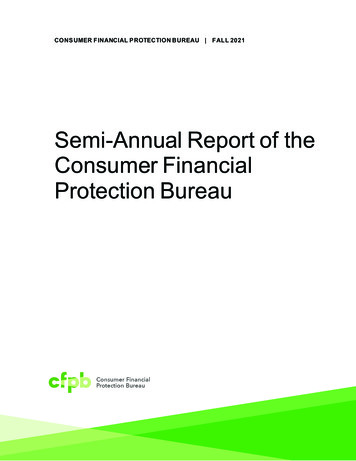
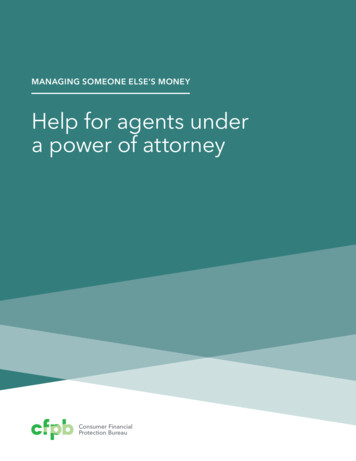
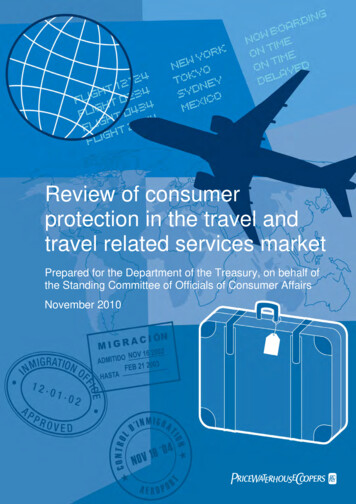
![Chapter 11. Consumer Protection. [Note] - Montgomery County, Maryland](/img/40/chap11.jpg)
